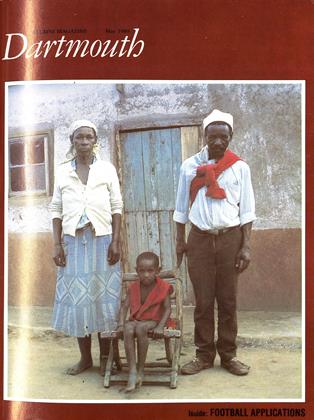CITIES OF THE AMERICAN WEST
John W. Reps '43
Princeton University Press, 1979. 827 pp. $75.
This is a book that begs to be leafed through, read, examined, and kept as a reference. John Reps has succeeded in an ambitious project to describe the physical design of western American cities.
Reps' "West" is primarily the transMissouri area, although he does identify the important eastern models and antecedents for western cities. Grid platting, with occasional allowance for structural or geographical needs, came to characterize American cities early. Design was simple, functional, and seldom unique or aesthetic. In the southwest this tradition blended with the Spanish model, which was planned in greater detail and which provided for a centripetal plaza, mission, or presidio.
Professor Reps is convinced of the cor- rectness of the view of those urban scholars who argue that the town was usually the cutting edge of western settlement. This position is counter to the old Turnerian view that often relegated the town to the role of a functional afterthought. In this argument Reps is pretty well in the mainstream of recent urban historiography.
The real contributions of this book are in providing a unique collection and analysis of actual town plans. There are over 500 maps, photographs, sketches, and "birds-eye" illustrations some in color in this book. One cannot leaf through them without being struck by the imaginative practicality and the unimaginative sameness that characterize so many American cities. Reps focuses primarily on those towns that succeeded, those that flourished, at least for a time. But he includes as well those ephemera of the frontier movement, towns that became "ghost towns," as well as those that never got beyond the plats and dreams of their promoters. Reps deals here primarily with the 19th-century city. He does include, though, a discussion of 20th-century trends and problems, including a plea for "creative but realistic visions of an urban future."
"Planning" in this book is narrowly defined as the spatial design, the physical lay-out of towns and cities. There is little on the human forces of politics, economics, and culture that transformed plats into organic and unique entities. This is not a criticism. Reps, a professor of city and regional planning at Cornell, is well aware of these complex forces. In this book his interest is narrower; nevertheless his scope is comprehensive.
John Reps dedicates this book "to the memory of three gifted teachers [Thomas MacKesey, Albert Carlson, and Walter Curt Behrendt] who helped me learn and with gratitude to Cornell and Dartmouth where they taught. I think they would be pleased with his magnificent book.
Professor Wright teaches the history of theAmerican West at Dartmouth.
 View Full Issue
View Full Issue
More From This Issue
-
 Cover Story
Cover StoryIn Two Worlds
May 1980 By Dan Nelson -
 Feature
FeatureIn Another Country
May 1980 By Beth Ann Baron -
 Article
ArticleAlchemist in Miniature
May 1980 By Michael Colacchio '80 -
 Article
ArticleScientific Humanist
May 1980 By M.B.R -
 Class Notes
Class Notes1978
May 1980 By JEFF IMMELT -
 Article
ArticlePainting Medicos Have Both "Life" and "Work"
May 1980 By D.C.G
James Wright
-
 Feature
FeatureDartmouth's Productivity
March 1996 By James Wright -
 Article
ArticleThe Shape of Things to Come
JANUARY 1999 By James Wright -
 Article
ArticleStanding Together
MARCH 1999 By James Wright -
 Article
ArticleBuilding Community
APRIL 1999 By James Wright -
 Article
ArticleWhat History Can and Cannot Teach
MAY 1999 By James Wright -
 Interview
Interview"We Expect Excellence"
May/June 2005 By James Wright
Books
-
 Books
BooksThe Congregational Churches of Vermon and their Ministry 1762-1914
June, 1915 -
 Books
BooksVolume three of the Dictionary of American Biography, published
January, 1930 -
 Books
BooksThe Liberty of Citizenship
March 1916 By F.A.U. -
 Books
BooksPREMIER MANUEL. GRAMMAIRE ET CIVILISATION FRANCAISES.
November 1954 By FRANCOIS DENOEU -
 Books
BooksTHE CHRISTENING PARTY.
February 1961 By NOEL PERRIN -
 Books
BooksSTRANGERS NO LONGER.
JULY 1963 By ROY B. CHAMBERLIN

